
Arming, Fueling and Briefing Phase.
Launch Phase.
Mission Phase.
Recovery Phase.
Debriefing.
Prior to each mission, the ground crews would have to arm and fuel the aircraft. The armament load would vary depending on the type of mission.
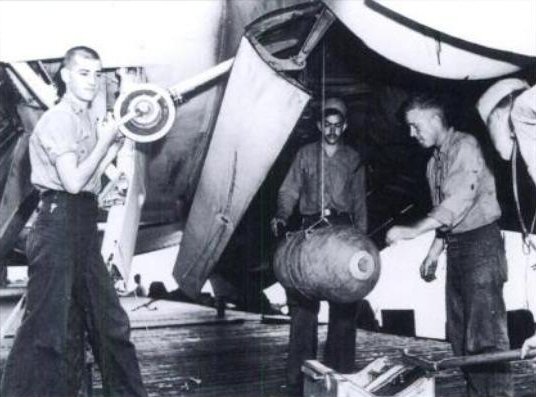 The ordnance men "ordies" use a winch to load a 250 lb bomb into a TBM.
A TBM could carry four 250 lb bombs.
The ordnance men "ordies" use a winch to load a 250 lb bomb into a TBM.
A TBM could carry four 250 lb bombs.
While the ground crews were working, the flight crews were receiving their mission briefing.
The crews would write down the navigation information and times on their kneeboards.
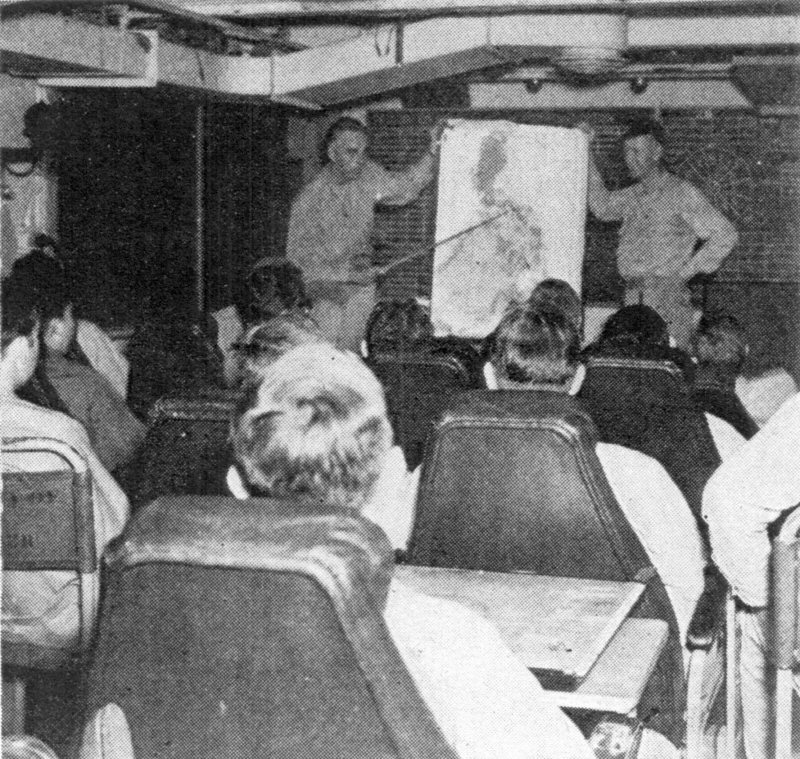
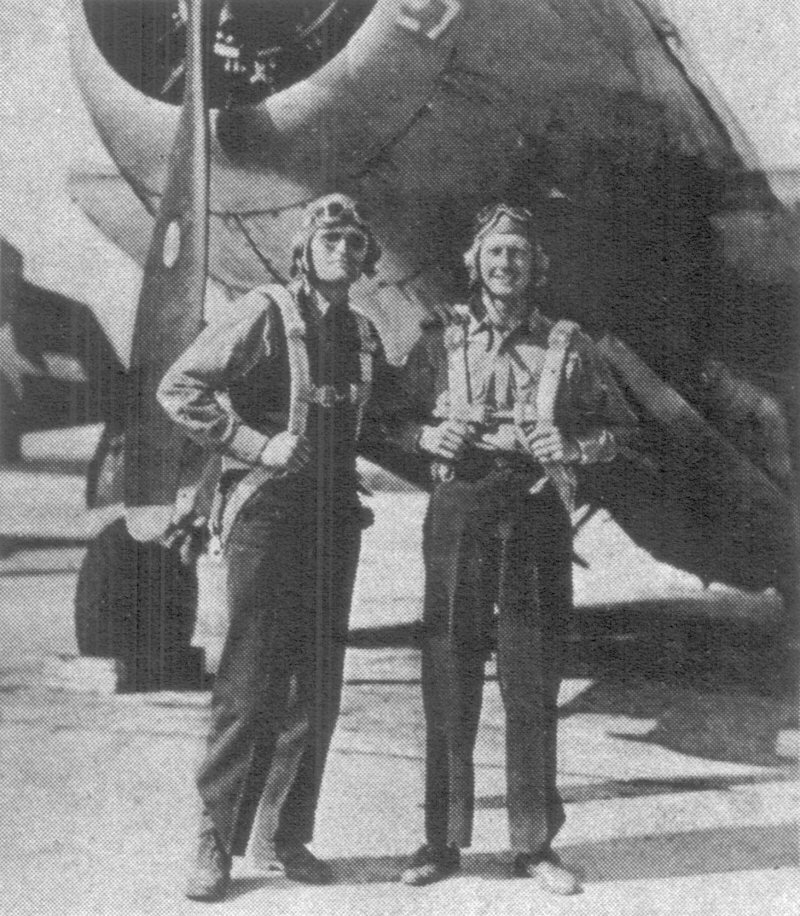 Lt Goly Henry and Lt Cmdr Jackson, in typical flight gear, prior to takeoff.
Lt Goly Henry and Lt Cmdr Jackson, in typical flight gear, prior to takeoff.
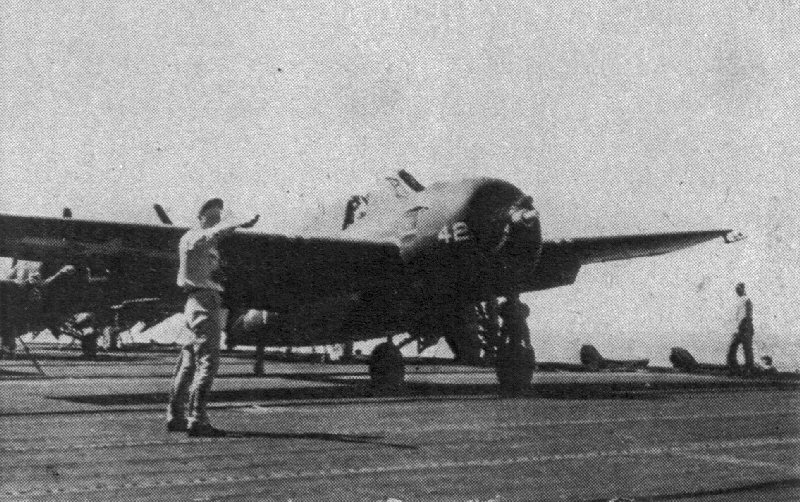 An VC-27 FM2 takes off from the U.S.S. Savo Island.
Note that the canopy is open to allow the pilot to quickly exit the plane in case of emergency.
An VC-27 FM2 takes off from the U.S.S. Savo Island.
Note that the canopy is open to allow the pilot to quickly exit the plane in case of emergency.
The carrier would initiate the launch phase by turning into the wind.
The heavily armed Avengers were launched using the catapults in the front, while Wildcats could take off under their own power, starting near the stern.
At one plane per minute, the U.S.S. Savo Island could launch all planes in one half hour.
Any aircraft that had to abort during this phase could not return to the carrier since there was no space in which to land.
The aircraft would have to ditch or find another place to land.
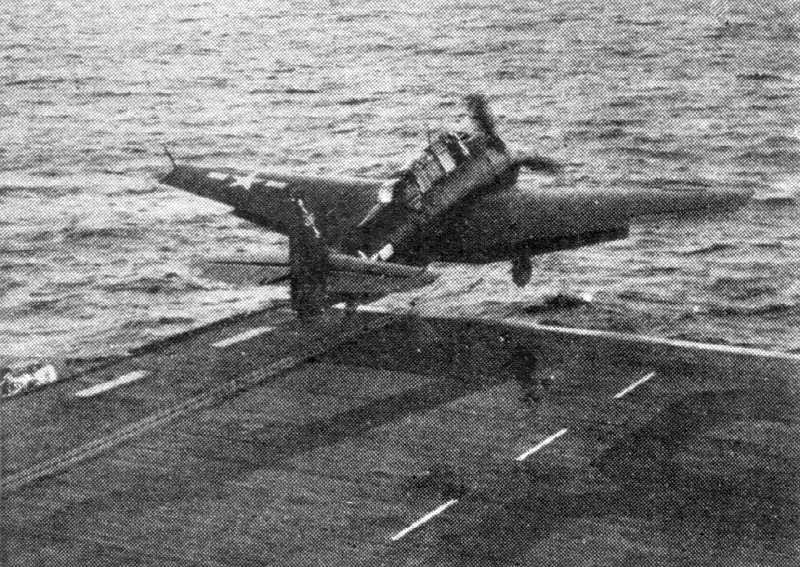 A VC-27 TBM takes off from the U.S.S. Savo Island using the catapult.
A VC-27 TBM takes off from the U.S.S. Savo Island using the catapult.
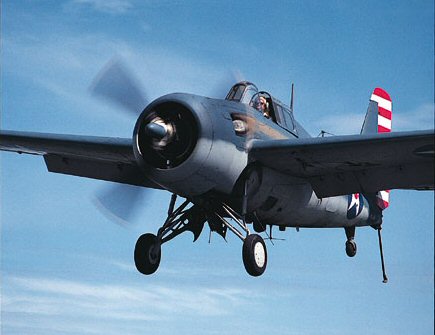
Source:Budd Davisson, all rights reserved.
This is how an FM2 would appear on final approach, with gear down, flaps down and hook down. The LSO, Lt(jg) Bill Diffee, was also a pilot and knew how to land a plane on a carrier. He was a hard taskmaster and required new pilots to practice their landings until he was satisfied that they could land safely on deck. |
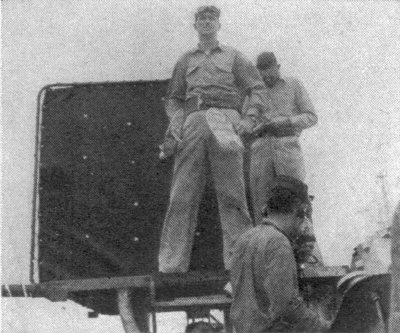
Lt(jg) Bill Diffee (LSO), Lt(jg) Ed Ludeman (ass't LSO), and (possibly) Arthur Gaylord, S 1/c AMM (ass't LSO) wait for the planes to arrive.
The black panel provided a contrasting backdrop so that pilots could see the LSO signals better.
There was a safety net to the left of the deck where they could jump in case of emergency.
It was put to good use.
|
|---|
The carrier would turn into the wind. The arresting wires would be readied and a cable barricade would be erected to protect the planes that had already landed. Each plane would land and attempt catch an arresting wire using the tailhook. The Landing Signal Officer (LSO) stood on the port (left) side of deck and helped direct the pilots to a safe landing. If the landing did not look right, the LSO would "wave off" the pilot and they would have to try again. If the pilot was unable to abort, the LSO would sometimes have to dive to the side to avoid being hit. A plane that missed the arresting wires would generally crash into the barricade. On rare occasions, they would bounce over the barricade and land on top of several parked planes.
After landing, the ground crews would detach the plane from the arresting wire, lower the barricade and direct the plane to the front of the ship. The crews would then reset the arresting wire and raise the barricade in time for the next landing.
|
CHAOS ON THE FLIGHT DECK
The flight deck of an aircraft carrier is a hazardous place to be when planes are taking off or landing. Murphy's Law is constantly lurking in the background, and woe be to the sailor who does not understand this. Storekeeper Jerry Baughman - now of Portland, Indiana, one of the enlisted plane handlers related his experiences: " On the Savo I was put in the gas crew. We had to start putting gas in planes when the first plane landed and continue until the last plane landed ... day in and day out it was probably more dangerous than the Japs. While filling the planes with gas we had to watch every plane that landed and if they missed the wires and the barrier they could be on top of the plane we were refueling and that happened several times. All you could do was jump down from the wing and I felt that being as close to the landing gear as I could be was the safest place. Lucky for me none of the planes that crashed forward of the barrier ever caught fire. I had many close calls with the gas crew ... then was transferred to the plane handling gang. That was no picnic either. The engines on all the planes were started on command at the same time. The plane handlers, one on each side of the plane, had to remove the tie down lines and chocks and go with the plane to the take-off point. After the plane took off we had to crawl on the deck to reach another plane and remember that the propellers were going at the same time. If you felt yourself being blown a little there were finger fittings you could try to get hold of to keep from being blown into a propeller behind you ... " Aviation Ordnance Mate 1st class Tobe Turpen (Lt. Goly Henry's gunner), now of Albuquerque, New Mexico, reminisces: " I wonder how many times [Lt.(jg) Bill] Diffee [Landing Signal Officer on the Savo Island] had to bail out into his emergency net. God, how naive we were. I never gave a single thought that we might crash on landing. The one time we did miss the cable and tore up several parked planes, we just crawled out and went about our business. I don't even remember discussing the happening with any of our aircrewmen. What a great attitude to have. I guess it comes with being young and feeling indestructible. " Lieutenant(jg) Forrest F. Glasgow, now of Nashville, Tennessee, was the Aviation Ordnance Officer aboard the Savo Island and a member of ship's company. He relates some of the other chaos that was experienced: "One incident involved an FM-2fighter loaded with a 250pound bomb under each wing. The pilot ... was just moving into take off position after the plane before him had just taken off ... one of my ordnance men came running over [to me] and hollered above the engine noise 'Mr Glasgow is the propeller on the bomb supposed to be spinning?' I should quickly explain that bombs are set off by fuses that are armed by a spinning propeller as the bomb falls through the air. Normally this propeller cannot spin because there is a wire though it that is pulled and stays with the plane when the bomb is dropped. Due to an oversight this wire had not been properly installed. I ran out and looked Sure enough the fuse was in the fully armed position. You don't really stop to think in these cases. I reached in and unscrewed the fuse and threw it over the side. I don't think the Captain of the ship ever knew, thank goodness because he would have wanted somebody's hide. Glasgow continued: [Another] time a TBM landed and opened its bomb bay doors which was standard practice. A bomb dropped out and rolled across the deck. It had not released when it was supposed to but had dropped out of the rack later after the pilot had closed the bomb bay doors. I'm glad the fuse wasn't armed. [One time] one of the fighter pilots forgot to turn off his gun switches before he landed and squeezed off several rounds of 50 caliber almost aimed at the bridge. Not all accidents happened on the flight deck. Glasgow continues: On that hectic 25 October morning my guys were hoisting bombs out of the bomb storage compartment below and let a 500 pound semi armor piercing bomb slip out of its shackle and drop from the hangar deck back to the deck below ... You can be sure the captain never heard about that one either." |
|---|
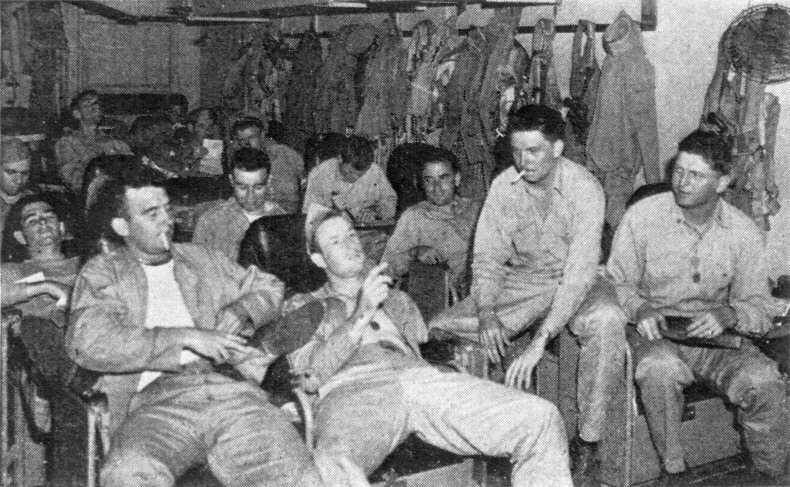 The crews gather in the ready room to decompress and compare notes after a mission.
In the front row, from left to right, are: Ass't LSO Ed Ludeman, TBM pilot John Yeoman, FM-2 pilot George Davidson, and LSO Bill Diffee.
The crews gather in the ready room to decompress and compare notes after a mission.
In the front row, from left to right, are: Ass't LSO Ed Ludeman, TBM pilot John Yeoman, FM-2 pilot George Davidson, and LSO Bill Diffee.
While the ground crews were getting ready for the next mission, the staff would debrief the crews. The staff would obtain a summary of the mission and information about enemy defenses.
If the crews had to fly another mission, they would take advantage of this time to grab a bite to eat and to use the head. On some days, the crews flew back-to-back missions from sunrise to sunset.